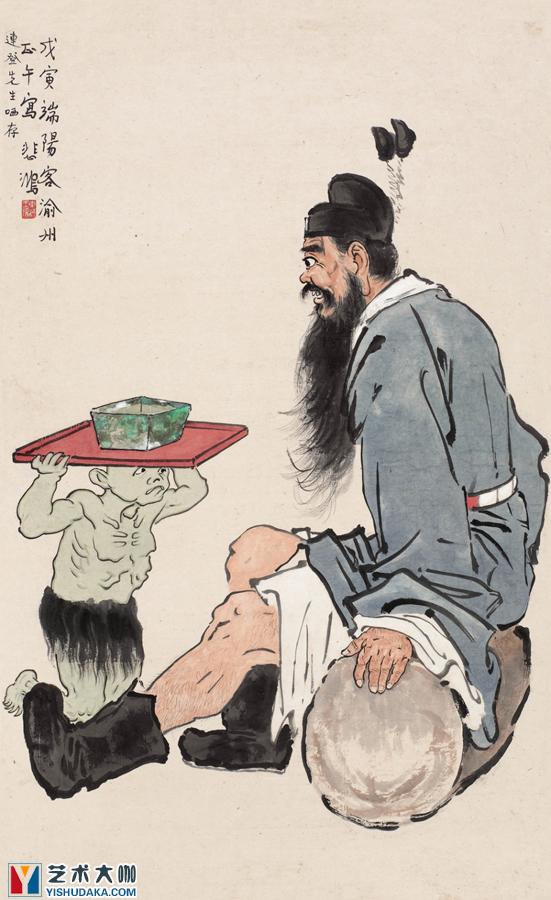|
||
 |
||
| Zhong Kui sits sideways |
| Size: |
| Painting species:chinese painting |
| Collect in: |
| Nationality:China painter |
| More Xu beihong chinese painting works appreciation |
| More information about works oil paintings : |
Zhong Kui sits sideways-Xu beihong of classic works,appreciate Xu beihong painter classic works ! This "Zhong Kui" has an unusual historical significance. During the War of Resistance Against Japanese Aggression in early 1939, Xu Beihong took his paintings to the Xinghai and Malaysia areas to hold a relief painting exhibition. In three years, he held four exhibitions and met many friends. During my stay in Malaysia, I was very impressed by hearing that the wealthy Penang businessman Lin Lien Teng had donated a huge amount of money to support the motherland’s war of resistance. He took this painting as a gift, and the title "Mr. Lien Teng kept." Lin Liandeng gave Lin Weiliang, a friend and business partner, which has been kept by Lin Weiliang’s family. "Zhong Kui" is not only Xu Beihong's fine works of painting in the 1930s, but it also bears witness to the noble sentiments of overseas Chinese and the motherland during the Anti-Japanese War, which are connected with the motherland and donated actively. It is of special significance and is worth cherishing. Zhong Kui is a frequent subject in Xu Beihong's portrait painting. This painting was created at the noon of the Dragon Boat Festival in 1938. In the painting, Zhong Kui sits sideways, accepting the case of a kneeling little ghost offering wine respectfully. The little ghost’s cautiousness is in sharp contrast with Zhong Kui’s eyes cracking and flaring, and the visual impact is extremely strong. It is true that the Chinese painting that the artist advocates should be directed at reality, "straightforward... it makes people know at a glance, there is something in common. Sex". Xu Beihong's paintings have three themes: one is friends, and various portraits of people with special reasons; the second is the toiling people; the third is the theme of chivalrous spirit: Jiufanggao with bountiful character, Tian Heng with loyalty, and Fengchen as a knight Xia, Jing Shisanniang and so on. Zhong Kui has become one of the painters' passions for eradicating injustice and getting rid of evil. Zhong Kui in his works often has no background, and rarely has heavy cunning gestures. The simple picture directly leads the viewer to the subject: whether it is a sword drawn, whether it is drunk, sitting or standing, catching ghosts and driving away evil is spiritual. A mission that never changes, and during this particular period of the War of Resistance, the direction of ghosts and evil is of course very clear. Most of the overseas Chinese from the 19th century to the beginning of the 20th century moved overseas because of poverty in their hometowns and difficulty in making a living. Therefore, they felt the deepest feelings about China's weakness. During Sun Yat-sen's revolution, he received a lot of help from overseas Chinese. Among them, Penang in Malaya was an area where he often went to raise funds. When the Anti-Japanese War broke out in 1937, Tan Kah Kee, the overseas Chinese leader in Sin Chew, proposed to organize the "Nanyang Overseas Chinese Relief Association" to relieve the recipients of the villagers and support the motherland’s war of resistance. This proposal received a warm response in the Southeast Asia. By 1940, various parts of Southeast Asia had More than two hundred relief societies were established, and donations from overseas Chinese were one of the reasons why China was able to maintain the financial and monetary order during the war. According to the available information, when the relief activities for the overseas Chinese first started, Lin Lianteng, a wealthy businessman in Penang, donated 100,000 latitude dollars for the first time and served as the chairman of the "Malayan Overseas Chinese Salvation Association". The Wuhan Chorus arrived. For the benefit performance in North Malaysia, he donated another 100,000 yuan (when Xu Beihong held an exhibition in Sin Chew in 1939, the general paintings sold for one hundred lat dollars), which fully demonstrated Lin's patriotism and love for the country. The Chinese publications published recently in Malaysia pointed out that Lin Lianteng’s donation was the most powerful financial supporter of overseas Chinese in supporting the war of resistance in the motherland at that time. He was the most popular leader of the Penang Chinese Society from 1930 to 1940. Lin Liandeng (1870-1963), a native of Huilai, Guangdong, immigrated to Malaya in 1893. He started from scratch and became a rubber giant in North Malaysia by operating farm plantation. Lin is also the leader of Chaozhou diaspora in Singapore and Malaysia. He is a philanthropist. He was the chairman of the Penang Teochew Guild Hall for 30 years, the chairman of the Malayan Teochew Guild Guild Association, the chairman of the Penang Chinese Chamber of Commerce, and he founded Hanjiang Primary School and Middle School. He still enjoys a high reputation in the local area. |
|
Zhong Kui sits sideways chinese painting appreciation of works,Famous China painter,Appreciate Xu beihong 's classic works:Zhong Kui sits sideways. More works of China painter 's influential painters are appreciated in art higher-ups:www.yishudaka.com.
|
| Welcome you to visit art higher-ups website |